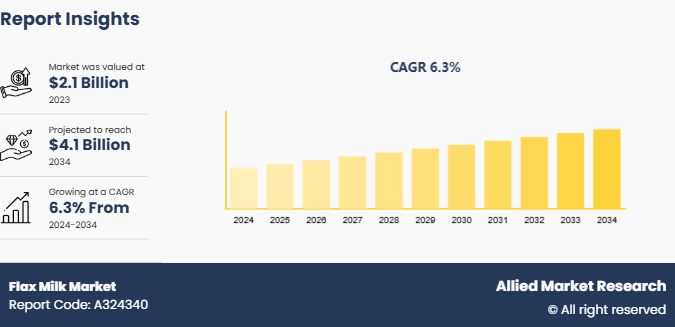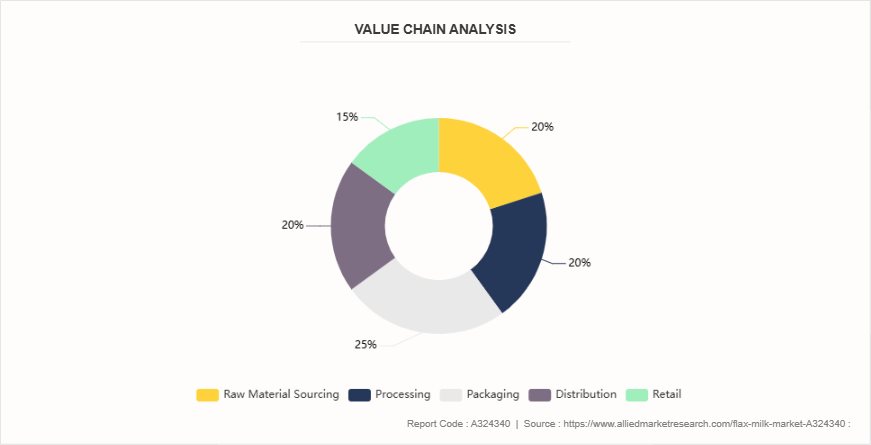Flax Milk Market Research, 2034
Market Introduction and Definition
The global flax milk market size was valued at $2.1 billion in 2023, and is projected to reach $4.1 billion by 2034, growing at a CAGR of 6.3% from 2024 to 2034. Flax milk is a plant-based, dairy-free beverage made from flax seeds and water, often enriched with additional vitamins and minerals to enhance its nutritional value. Flax milk is known for its mild flavor and creamy texture, and it is a popular alternative to traditional dairy milk, especially among those following vegan, lactose-free, or gluten-free diets. Flax milk is particularly popular due to its high content of omega-3 fatty acids, which are crucial for heart health, reducing inflammation, and supporting brain function. Rise in awareness of the importance of omega-3s in maintaining overall health has contributed to the growth of flax milk industry.

Key Takeaways
- The flax milk market study covers 20 countries. The research includes a segment analysis of each country in terms of value for the forecast period.
- More than 1, 500 product literatures, industry releases, annual reports, and other such documents of major plant-based beverages industry participants along with authentic industry journals, trade associations' releases, and government websites have been reviewed for generating high-value industry insights.
- The flax milk market study integrated high-quality data, professional opinions and analysis, and critical independent perspectives. The research approach is intended to provide a balanced view of global markets and to assist stakeholders in making educated decisions in order to achieve their most ambitious growth objectives.
Key market dynamics
- The increasing shift toward plant-based diets due to health concerns, environmental consciousness, and lactose intolerance is a key driver of the flax milk market growth. As more consumers opt for vegan or dairy-free lifestyles, the demand for plant-based milk alternatives has surged. Flax milk, being a nutritional powerhouse with high omega-3 fatty acids and fiber, is seen as an appealing option for those seeking healthier milk alternatives that are also environmentally friendly. This growing trend has led to increase in the variety of plant-based milks available on the market, with flax milk gaining significant attention for its unique nutritional profile and sustainability credentials.
- Flax milk is particularly popular due to its high content of omega-3 fatty acids, which are crucial for heart health, reducing inflammation, and supporting brain function. Rise in awareness of the importance of omega-3s in maintaining overall health has contributed to the growing flax milk market demand. Consumers are becoming more health-conscious, looking for dairy-free alternatives that not only provide essential nutrients but also support their wellness goals. This trend is particularly prominent among individuals with specific health conditions, such as cardiovascular diseases, where omega-3 intake is recommended, and those looking for natural ways to improve their diet which is expected to drive flax milk market size.
- As food allergies and intolerances become more prevalent, the demand for allergen-free products is surging. Flax milk’s natural absence of common allergens such as dairy, nuts, soy, and gluten make it an appealing choice for people with dietary restrictions. This driver is especially significant as parents seek safe, nutritious alternatives for children with allergies. Brands such as Good Karma Foods have leveraged this by marketing their flax milk as an ideal option for those with sensitivities, helping to create a loyal customer base during flax milk market forecast.

Value Chain Analysis
Each stage in the value chain contributes to the overall value of flax milk market and influences factors such as pricing, quality, and customer satisfaction. Analyzing each step helps identify areas for improvement and opportunities for innovation in the market.
Raw Material Sourcing
The flax milk value chain begins with sourcing high-quality flax seeds. These seeds are often sourced from farms, which must ensure that the flax is grown under sustainable practices. The quality of the flax seeds directly impacts the flavor, texture, and nutritional content of the milk.
Processing
Flax seeds are processed to extract oil and produce flax milk. The seeds are washed, ground, and blended with water to create a smooth liquid. The mixture undergoes filtration to remove solid particles and improve consistency. During this stage, producers may add fortifications such as vitamins, minerals, and flavorings. This processing ensures that the final product is nutrient-rich, smooth, and free from impurities while maintaining its health benefits, such as omega-3 fatty acids.
Packaging
After processing, flax milk is packaged in various sizes and forms, often in eco-friendly cartons, bottles, or Tetra Paks. Packaging plays a crucial role in maintaining product quality, especially in terms of shelf life.
Distribution
Flax milk is distributed through various channels, including supermarkets, health food stores, and online retail platforms. Distribution networks are vital for ensuring the product reaches consumers efficiently and at the right time.
Retail
Retailers play a key role in ensuring the visibility and availability of flax milk in stores. The product is typically placed in the refrigerated section of supermarkets or health food stores. Retailers also provide valuable consumer data to manufacturers about purchasing behavior, allowing for tailored marketing strategies.
Market Segmentation
The flax milk market is segmented into product type, distribution channel, and region. Based on product type, the market is segmented into original/plain flax milk, flavored flax milk, and unsweetened flax milk. By distribution channel, the market is classified into hypermarkets and supermarkets, specialty stores, convenience stores, online retail, and others. Region-wise, the market is analyzed across North America, Europe, Asia-Pacific, and LAMEA.
Regional Market Outlook
North America holds flax milk market share in 2023. With rise in awareness about the adverse health effects of dairy consumption, including lactose intolerance, allergies, and increased cholesterol levels, many consumers are opting for dairy-free alternatives. Flax milk, being rich in omega-3 fatty acids, fiber, and antioxidants, offers a healthy and nutritious option for individuals seeking to improve overall well-being. Europe region held the significant flax milk market share in 2023.
Industry Trends
- Consumers are becoming more aware of the importance of incorporating functional ingredients, such as antioxidants, vitamins, and minerals, into their diets. Flax milk fits perfectly into this trend as it is often fortified with essential nutrients such as calcium, vitamin D, and B12, making it an excellent choice for individuals looking to improve their overall health. Brands are responding to this trend by offering flax milk products enriched with additional nutrients, such as vitamin A and E, to cater to the rising demand for functional beverages in flax milk industry.
- The plant-based milk segment, which includes flax milk, is becoming increasingly mainstream, as more consumers are incorporating plant-based options into their daily lives. With traditional dairy milk consumption on the decline, plant-based milks like flax milk are seeing increased shelf space in grocery stores and more options available for consumers. This trend is reinforced by growing environmental concerns over the dairy industry’s resource consumption and greenhouse gas emissions, encouraging people to make more sustainable food choices which is expected to propel the growth of flax milk market.
- Consumers are increasingly demanding products that are simple, transparent, and free from artificial additives and preservatives. Thus, flax milk brands are focusing on creating "clean label" products with minimal ingredients. This trend emphasizes the importance of transparency in food labeling, with many consumers preferring products that are free from additives, sugars, and unnecessary chemicals which is expected to propel the growth of flax milk market.
Competitive Landscape
The major players operating in the flax milk market include Danone S.A., Good Karma Foods, Malibu Mylk, Lil Bucks, Elmhurst Milked Direct LLC, Ripple Foods, Califia Farms, Pacific Foods, Dream Plant-Based, and Malk Organics.
Key Benefits For Stakeholders
- This report provides a quantitative analysis of the market segments, current trends, estimations, and dynamics of the flax milk market analysis from 2024 to 2034 to identify the prevailing flax milk market opportunities.
- The market research is offered along with information related to key drivers, restraints, and opportunities.
- Porter's five forces analysis highlights the potency of buyers and suppliers to enable stakeholders make profit-oriented business decisions and strengthen their supplier-buyer network.
- In-depth analysis of the flax milk market segmentation assists to determine the prevailing market opportunities.
- Major countries in each region are mapped according to their revenue contribution to the global market.
- Market player positioning facilitates benchmarking and provides a clear understanding of the present position of the market players.
- The report includes the analysis of the regional as well as global flax milk market trends, key players, market segments, application areas, and market growth strategies.
Flax Milk Market Report Highlights
| Aspects | Details |
| Market Size By 2034 | USD 4.1 Billion |
| Growth Rate | CAGR of 6.3% |
| Forecast period | 2024 - 2034 |
| Report Pages | 295 |
| By Product Type |
|
| By Distribution Channel |
|
| By Region |
|
| Key Market Players | Dream Plant-Based, Elmhurst Milked Direct LLC, MALK Organics, LLC, Good Karma Foods, Ripple Foods, Danone S.A., Califia Farms, Lil Bucks, Pacific Foods, Malibu Mylk |
The global flax milk market was valued at $2.1 billion in 2023, and is projected to reach $4.1 billion by 2034, growing at a CAGR of 6.3% from 2024 to 2034.
The flax milk market is segmented into product type, distribution channel, and region. Based on product type, the market is segmented into original/plain flax milk, flavored flax milk, and unsweetened flax milk. By distribution channel, the market is classified into hypermarkets and supermarkets, specialty stores, convenience stores, online retail, and others. Region-wise, the market is analyzed across North America, Europe, Asia-Pacific, and LAMEA.
North America is the largest regional market for flax milk
The major players operating in the flax milk market include Danone S.A., Good Karma Foods, Malibu Mylk, Lil Bucks, Elmhurst Milked Direct LLC, Ripple Foods, Califia Farms, Pacific Foods, Dream Plant-Based, and Malk Organics.
The global flax milk market report is available on request on the website of Allied Market Research.
Loading Table Of Content...



